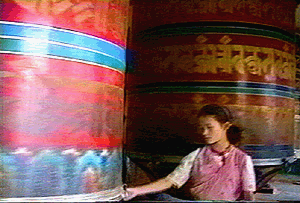Journal of the Buddhist Peace Fellowship

Film produced & photographed by Barbara Green
Reviewed by Anita Barrows
Barbara Green's moving and beautiful film about a Tibetan community in exile portrays away of life in which meditation, work, study, domesticity, and play are a seamless whole.
When I showed Tashi Jong to my psychology graduate students, one of themcommented, Now I can see what helps the Tibetan suffer less from post-traumatic stress disorder. It is clear that their involvement with community and their ability to preserve the forms and meanings of their practice assures their spiritual and psychological survival.
After fleeing the Chinese crackdown in Tibet, Khamtrul Rinpoche (d. 1980) founded the Tashi Jong community in order to keep the teachings and sacred arts of Tibet alive. Located in northern India, Tashi Jong (which means "auspicious valley" ) includes the monastery, and the life of the 400 or so who live here (including children and lay people) is centered in the dharma. The monastery is like a sun, Green is told. It is the light and warmth of our hearts.
Green’s penetrating photography takes us into the daily life of Tashi Jong. We see a nun bending to sweep a courtyard while chanting prayers; an elderly woman walking down a footpath, prayer wheel in hand; a lay person painting a thangka with devotion and unbroken concentration; young children learning to read, write, and dance. It is notable that no one in the film seems to be lost, bored, apathetic. In contrast to films we have seen of refugees in other setting, there is no feeling that the people of Tashi Jong are waiting for real life to begin again somewhere else.
This award-winning film is a visual feast, both for Green's shot of the lush region surrounding Tashi Jong and for the colorful regalia-the reds, golds, saffrons-of the people themselves. Particularly memorable are scenes of the Lama Dances, performed yearly to celebrate Padmasambhava's birthday, with expressive masks and elaborate costumes. But what I love best in the film-which I savor over and over again-are the very ordinary instances, like the woman dipping a red onion into a pot of water, then squatting to chop it. The film shows us life lived with full knowledge both of its impermanence and its sacredness.
Anita Barrows is a poet, translator, psychologist, and peace activist, who lives in Berkeley with her two daughters. Her forthcoming book of poetry, A Record, will be published in November.